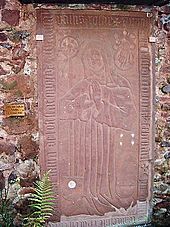Anna of Lustadt
Anna von Lustadt († January 25, 1485 in Kerzenheim , Rosenthalerhof ) was a noblewoman from the lords of Lustadt and abbess of the Cistercian monastery in Rosenthal (Palatinate) .
Parentage and family
She came from the noble family von Lustadt, which had its seat in the Palatinate municipality of Oberlustadt . A genealogy of the family has not been passed down, it appears for the first time in a document with Conrad von Lustadt in 1219 and is often associated with the diocese of Speyer . Later its members were vassals of the Electoral Palatinate . The last of the Squire Heinrich is mentioned in documents from Lustadt 1494, in Lower Hochstadt an estate of Count Eberhard of County of Montbéliard to fief wore. A Margarete von Lustadt was the mother (or stepmother) of the Basel bishop Johann V. von Venningen . After the tombstone of Abbess Anna von Lustadt, the family had a wall anchor in the coat of arms.
The abbess's parents are not known. In addition to the paternal coat of arms of the von Lustadt family, the maternal coat of arms with a double crossbar appears on the tombstone; it is still unexplained.
The brother Annas, Erpfo of Lustadt, served in 1456 as the Electoral Palatinate Vizedom in Neustadt on the Wine Route . In a fief book of Elector Friedrich I of the Palatinate , he and his brother Jakob von Lustadt are named as Electoral Palatinate vassals at Oppenheim Castle .
Live and act
Anna von Lustadt appears for the first time in 1444 as Abbess von Rosenthal. She was the 9th head of the community and increased the monastery property in 1452 and 1456 by purchasing goods, etc. a. a farm in Bechtolsheim . Several nuns from respected noble families entered there in their day. In the Mainz collegiate feud , the convent and its surroundings were affected in 1461/62. In 1463 it appears in a document when it accepted the oath of obedience from a priest who was given the parish of St. Stephan in Asselheim on behalf of the monastery .
With the help of Worms Bishop Reinhard I. von Sickingen , Anna von Lustadt tried to reform monastic life. She was supported in this by the sovereign Elisabeth, widow of Count Johann III. von Nassau-Saarbrücken († 1472) and daughter of Count Ludwig I of Württemberg-Urach . However, the plan was not fully successful until the next but one Abbess Margaretha von Venningen .
Anna died in 1485 after more than 40 years in office and was buried in the monastery. Her gravestone with a relief figure is preserved in the church ruins.
literature
- Franz Xaver Remling : Documented history of the former abbeys and monasteries in what is now Rhine Bavaria. Volume 1. Neustadt an der Haardt 1836, p. 285, (digital scan) .
- Fritz Heckel: The gentlemen of Lustadt and their significance. In: Pfälzer Heimat , born 1953, pp. 12-16.
Individual evidence
- ^ Georg Friedrich Böhn: Contributions to the territorial history of the district of Alzey , Volume 1 of: Mainzer Abhandlungen zur Mittel und neueer Geschichte , 1958, p. 118; (Detail scan)
- ↑ Franz Xaver Glasschröder : Documents on the Palatinate Church History in the Middle Ages , Munich, 1903, page 221, document regist No. 535
- ^ Franz Xaver Remling: Documented history of the former abbeys and monasteries in what is now Rhine Bavaria. Volume 1. Neustadt an der Haardt 1836, p. 286; (Digital scan)
| personal data | |
|---|---|
| SURNAME | Lustadt, Anna von |
| BRIEF DESCRIPTION | Noblewoman, Cistercian, abbess in the monastery Rosenthal (Palatinate) |
| DATE OF BIRTH | 14th century or 15th century |
| DATE OF DEATH | January 25, 1485 |
| Place of death | Candle home , Rosenthalerhof |


